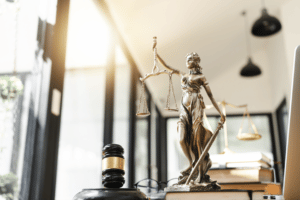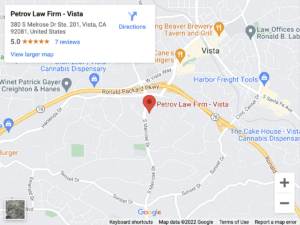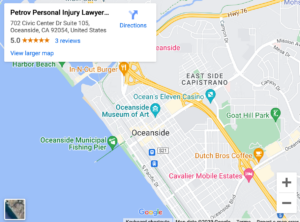
How do we know whether someone’s claim is true or false? Without a well-developed system of evidence, individual intuition would make the decision, resulting in a highly unpredictable legal system. Fortunately, the California Evidence Code provides guidance both inside and outside of court.
The Weight of the Evidence

It’s important that the evidence you submit be admissible under the California Evidence Code. However, the weight of your evidence is also important. How much evidence do you have to submit to win your claim? Below is an explanation of three of the most important evidentiary standards.
“A Preponderance of the Evidence”
“A preponderance of the evidence” is enough evidence, all things considered, to convince a court that your version of the story is more than 50% likely to be true. A 51% likelihood is enough. “A preponderance of the evidence” is the standard you need to meet to prove each element of a negligence claim, which is the basis of most personal injury cases.
“Clear and Convincing Evidence”
“Clear and convincing evidence” is a more demanding standard than “a preponderance of the evidence.” In personal injury law, courts use it to assess a plaintiff’s demand for punitive damages. If the plaintiff fails to present clear and convincing evidence of entitlement to punitive damages, the court will not award them.
“Beyond a Reasonable Doubt”
“Beyond a reasonable doubt” is the standard a prosecutor needs to meet to win a criminal conviction. You don’t need to meet this standard for any purpose in a personal injury claim.
Common Types of Evidence Used in Personal Injury Cases
Following is a description of some of the most popular forms of evidence used in personal injury claims.
Accident Reports
When the police respond to a traffic accident, they typically take down the information they need to file an accident report. Despite the fact that an accident report is one of the most commonly requested forms of evidence, you usually cannot use an accident report in court. Instead, you must question the police officer who created the police report.
Medical Records
Medical records are authoritative because they are created by professionals, and these professionals are neutral third parties with no personal stake in your claim. You might need emergency room records, hospital records, medical bills, and other medical records to establish your claim.
Employment Records
If you were employed at the time of your accident and missed work because of the accident, you will need your employment records to establish your lost earnings.
Photographic Evidence
If your injuries were not too serious, you might have been able to take photos at the scene of the accident. These photos might include injuries, property damage, the positioning of the vehicles (if it was a traffic accident), the surroundings of the accident, etc.
Eyewitness Testimony
Always try to get contact details for witnesses to the accident. Their testimony can be useful in settlement negotiations as well as court proceedings.
Insurance Information
If you can, make sure to exchange insurance details with the other driver in a traffic accident. In other kinds of accidents, you need to get the insurance details of the at-fault party. You should also check the extent of your own insurance coverage.
Independent Medical Exams
If you are filing a third-party claim against the at-fault party’s insurance policy, they might want their doctor to examine you. Your own insurance company might make the same request of you. Speak with your lawyer about this.
Expert Witness Testimony
Some kinds of claims, especially medical malpractice and product liability claims, typically require the testimony of expert witnesses. Most expert witnesses are professionals–they retired from their field of expertise and devote their full time to serving as expert witnesses. These witnesses can withstand the pressure that a cross-examining attorney can place on a witness.
Inadmissible Evidence in California
The California Evidence Code excludes certain types of evidence from consideration. It isn’t that the jury will reject it—it’s that the court will not even let the jury see it. This doesn’t apply to settlement negotiations.
Nevertheless, the opposing party is unlikely to consider evidence that a court will never see (except for the accident report, which they might insist upon). Following are some examples of inadmissible evidence.
Irrelevant Evidence
Evidence must relate to the issue in dispute. Sometimes it’s tricky to determine what is and is not relevant. Evidence of a sexual assault victim’s past sexual promiscuity, for example, is inadmissible under most circumstances.
Prejudicial Evidence
Prejudicial evidence is evidence that is so emotionally charged that it might tempt the jury to jump to conclusions. Graphic photos of a murder scene, for example, might fall into this category.
Evidence of Subsequent Remedial Measures
Suppose a defendant repairs a stairwell railing that was the site of your slip and fall accident. Should you be able to use evidence of the repair to prove that the stairwell railing was defective in the first place? It would seem so at first glance. A court will reject this evidence, however, because allowing it would provide defendants with a disincentive to repair dangerous conditions.
A Vista Personal Injury Lawyer Can Help You Gather Admissible Evidence
As you might have guessed by now, it is not always obvious which evidence is admissible and which evidence is not. It is also not always obvious which evidence will turn out to be the most useful or credible. Nevertheless, an experienced Vista personal injury attorney should know.
Schedule a Free Consultation With Our Vista Personal Injury Lawyers
Contact Petrov Personal Injury Lawyers to schedule your free consultation with an experienced attorney or give a call at (619) 344-0360.


